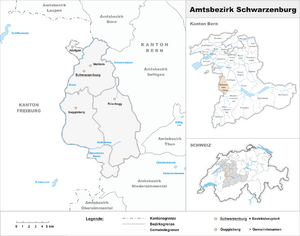Schwarzenburg District facts for kids
Quick facts for kids
Schwarzenburg District
Amtsbezirk Schwarzenburg
|
|
|---|---|
|
District
|
|
 |
|
| Country | |
| Canton | |
| Capital | Wahlern |
| Area | |
| • Total | 157 km2 (61 sq mi) |
| Population
(2007)
|
|
| • Total | 10,002 |
| • Density | 63.71/km2 (165.0/sq mi) |
| Time zone | UTC+1 (CET) |
| • Summer (DST) | UTC+2 (CEST) |
| Municipalities | 4 |
The Schwarzenburg District was an important administrative area in the Canton of Bern, Switzerland. It was like a small region with its own main town, Schwarzenburg, which was located within the larger municipality of Wahlern. This district was one of 26 similar areas that helped organize the Canton of Bern.
What Was the Schwarzenburg District?
The Schwarzenburg District was a way to manage a part of the Canton of Bern. Think of a canton as being similar to a state or a large county. Within this canton, districts were smaller areas that helped with local government and services.
This district covered about 157 square kilometers (which is about 60 square miles). In 2007, around 10,000 people lived there.
Towns and Villages
The Schwarzenburg District was made up of four different municipalities. A municipality is like a town or a group of villages that share a local government.
The four municipalities in the district were:
- Albligen: This municipality had a population of 465 people and covered 4.3 square kilometers.
- Guggisberg: This was a larger municipality with 1,602 people and an area of 54.9 square kilometers.
- Rüschegg: This municipality had 1,708 people living in an area of 57.4 square kilometers.
- Wahlern: This was the largest municipality, with 6,227 people. It covered 40.6 square kilometers and was home to the district's capital, Schwarzenburg.
History of the District
The Schwarzenburg District was an important part of the Canton of Bern for many years. However, like many administrative areas, things can change over time. In 2010, Switzerland reorganized some of its districts. The Schwarzenburg District was then combined with other areas to form new administrative regions. This means it no longer exists as a separate district today.
See also
 In Spanish: Distrito de Schwarzenburg para niños
In Spanish: Distrito de Schwarzenburg para niños

